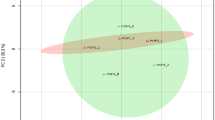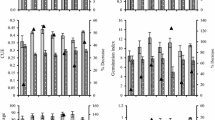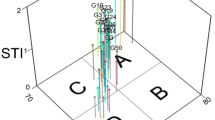Abstract
Plants respond to a variety of abiotic and biotic signals influencing their growth and development. Although the responses are different between plants, in case the growth of medicinal plant, yield production and responses to environmental stresses is right dependent on genotype. Foeniculum vulgare (fennel) is annual, biennial or perennial plant, belongs to Apiaceae family. In this study, effect of water stress was investigated among 10 different fennel genotypes in completely random blocks design during years 2012–2014. The plant height, biologic yield, thousand grain weight, ash percentage and activities of CAT, APX and GPX enzymes and proline content were evaluated and compared between genotypes. It was evident that Shiraz genotype occupied the highest level position in majority of traits such as CAT activity, thousand grain weights, biologic yield and proline content. The correlation analysis revealed that proline level had the highest correlation with the thousand grain weight. Based on the components analysis in the first year, four components have values greater than 1 and the first component alone explained 40% of the total variation. The CAT activity had the highest coefficient in the first component. In the second year, three components had values greater than 1 which the first component was explained 35% of variation and thousand grain weight showed the highest coefficient. Cluster analysis divided the parameters studied in the three groups in both years. Biplot results showed that the Shiraz genotype was in the best position with respect to the first component and possess the highest yield production rate compared to other genotypes.









Similar content being viewed by others
References
Bates, L. S., Waldern, R. P., & Teare, I. D. (1973). Rapid determination of free proline for water stress study. Plant and Soil, 39, 205–207.
Beers, R., & Size, I. (1969). A spectrophotometric method lumber monoterpene in pepper mint. Plant Physiology, 44, 173–179.
Bernath, J., Nemeth, E., Kattaa, A., & Hethelyi, E. (1996). Morphological and chemical evaluation of Fennel (Foeniculum vulgare Mill.) population of different origin. Journal of Essential Oil Research, 8, 247–253.
Bruyas-Bertholon, V., Lachaux, A., Dubois, J. P., Fourneret, P., & Letrilliart, L. (2012). Which treatments for infantile colics? La Presse Médicale, 41(7–8), 404–410.
Cosge, B., Kiralan, B., & Gurbuz, B. (2008). Characteristics of fatty acids and essential oil from sweet fennel (F. vulgare Mill. var. dulce) and bitter fennel fruits (F. vulgare Mill. var. vulgare) growing in Turkey. Natural Product Research, 22, 1011–1016.
Farshadfar, E., Mohammadi, M., & Haghparast, R. (2011). Diallel analysis of agronomic, physiological and metabolite indicators of drought tolerance in bread wheat (Triticum aestivum L.). International Journal of Plant Breeding, 1, 42–47.
Gaspar, T., Franck, T., Bisbis, B., Kevers, C., Jouve, L., Hausman, J. F., et al. (2002). Concepts in plant stress physiology. Application to plant tissue cultures. Plant Growth Regulation, 37, 263–285.
Kuznetsov, V. V., & Shevyakova, N. I. (1999). Proline under stress: biological role, metabolism, and regulation. Russian Journal of Plant Physiology, 46(2), 274–287.
Levitt, J. (1980). Responses of plants to environmental stresses. Vol. I Chilling, freezing, and high temperature stress. London: Academic Press.
Lucinewton, S., Raul, N., Carvalho, J., Mirian, B., Lin, C., & Angela, A. (2005). Supercritical fluid extraction from fennel (Foeniculum vulgare): Global yield, composition and kinetic data. The Journal of Supercritical Fluids, 35, 212–219.
Mimica-Dukić, N., Kujundžić, S., Soković, M., & Couladis, M. (2003). Essential oil composition and antifungal activity of Foeniculum vulgare Mill. Obtained by different distillation conditions. Phytotherapy Research, 17(4), 368–371.
Morphy, D. P. L., Cox, T. S., & Rodgers, D. M. (1992). A multivariate approach to the analysis of cereal crops structure at harvest. European Society for Agronomy, 23, 194–195.
Nakano, Y., & Asada, K. (1981). Hydrogen peroxide is scavenged by ascorbate-specific peroxidase in spinach chloroplasts. Plant and Cell Physiology, 22, 867–880.
Oktay, M., Gulcin, I., & Kufrevioglu, O. I. (2003). Determination of in vitro antioxidant activity of fennel (Foeniculum vulgare) seed extracts. LWT-Food Science and Technology, 36(2), 263–271.
Perkins, F. O. (1972). The ultrastructure of holdfasts,“rhizoids”, and “slime tracks” in thraustochytriaceous fungi and Labyrinthula spp. Archiv für Mikrobiologie, 84(2), 95–118.
Perry, R., Hunt, K., & Ernst, E. (2011). Nutritional supplements and other complementary medicines for infantile colic: A systematic review. Pediatrics, 127(4), 720–733.
Raghavan, S. (2006). Handbook of spices, seasoning and flavourings (pp. 63–64). Boca Raton: CRC Press.
Sánchez-Moreno, C., Larrauri, J. A., & Saura-Calixto, F. (1998). A procedure to measure the antiradical efficiency of polyphenols. Journal of the Science of Food and Agriculture, 76(2), 270–276.
Shojaee, S., Zehtabian, G., Jafary, M., & Khosravi, H. (2017). Evaluating the application of wastewater in different soil depths (Case study: Zabol). Pollution, 3(1), 113–121.
Sudhakar, C., Lakshmi, A., & Giridarakumar, S. (2001). Changes in the antioxidant enzyme efficacy in two high yielding genotypes of mulberry (Morus alba L.) under NaCl salinity. Plant Science, 161(3), 613–619.
Urbanek, H., Kuzniak-Gebarowska, E., & Herka, K. (1991). Elicitation of defense responses in bean leaves by Botrytis cinerea polygalacturonase. Acta Physiologiae Plantarum, 13, 43–50.
Acknowledgements
Authors are grateful to the Cultural Affairs of university of Zabol for their unending effort to provide financial support to undertake this work.
Author information
Authors and Affiliations
Corresponding author
Rights and permissions
About this article
Cite this article
Poudineh, Z., Fakheri, B.A., Sirosmehr, A.R. et al. Effect of drought stress on the morphology and antioxidant enzymes activity of Foeniculum vulgare cultivars in Sistan. Ind J Plant Physiol. 23, 283–292 (2018). https://doi.org/10.1007/s40502-018-0370-z
Received:
Accepted:
Published:
Issue Date:
DOI: https://doi.org/10.1007/s40502-018-0370-z




